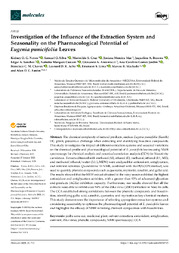Investigation of the influence of the extraction system and seasonality on the pharmacological potential of Eugenia punicifolia leaves.
Investigation of the influence of the extraction system and seasonality on the pharmacological potential of Eugenia punicifolia leaves.
Author(s): NEVES, K. O. G.; SILVA, S. O.; CRUZ, M. S.; MAR, J. M.; BEZERRA, J. A.; SANCHES, E. A.; CASSANI, N. M.; ANTONIUCCI, G. A.; JARDIM, A. C. G.; CHAVES, F. C. M.; ACHO, L. D. R.; LIMA, E. S.; MACHADO, M. B.; SANTOS, A. D. C.
Summary: The chemical complexity of natural products, such as Eugenia punicifolia (Kunth) DC. plant, presents a challenge when extracting and identifying bioactive compounds. This study investigates the impact of different extraction systems and seasonal variations on the chemical profile and pharmacological potential of E. punicifolia leaves using NMR spectroscopy for chemical analysis and canonical correlation analysis (CCA) for bioactivity correlation. Extracts obtained with methanol (M), ethanol (E), methanol/ethanol (1:1, ME), and methanol/ethanol/water (3:1:1, MEW) were analyzed for antioxidant, antiglycation, and antiviral activities. Quantitative H-1 NMR, combined with the PULCON method, was used to quantify phenolic compounds such as quercetin, myricetin, catechin, and gallic acid. The results showed that the MEW extract obtained in the rainy season exhibited the highest antioxidant and antiglycation activities, with a greater than 93% of advanced-glycation end-products (AGEs) inhibition capacity. Furthermore, our results showed that all the extracts were able to inhibit over 94% of the Zika virus (ZIKV) infection in Vero E6 cells. The CCA established strong correlations between the phenolic compounds and bioactivities, identifying gallic acid, catechin, quercetin, and myricetin as key chemical markers. This study demonstrates the importance of selecting appropriate extraction systems and considering seasonality to optimize the pharmacological potential of E. punicifolia leaves and highlights the efficacy of NMR in linking chemical composition with bioactivities.
Publication year: 2025
Types of publication: Journal article
Unit: Embrapa Western Amazon
Observation
Some of Embrapa's publications are published as ePub files. To read them, use or download one of the following free software options to your computer or mobile device. Android: Google Play Books; IOS: iBooks; Windows and Linux: Calibre.
Access other publications
Access the Agricultural Research Database (BDPA) to consult Embrapa's full library collection and records.
Visit Embrapa Bookstore to purchase books and other publications sold by Embrapa.

